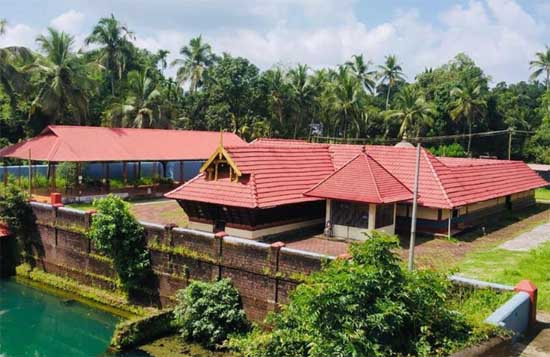Vellarakkad Sree Rama temple is located at Vellarakad, 5 km east of Kunnamkulam, in Thrissur district, Kerala. The temple is dedicated to Bhagavan Sri Rama. The annual Sri Rama Navami festival in Malayalam Meena Masam (March – April) is the most important festival in the temple.
The murti of Sri Rama resembles the Chaturbhahu Vishnu form with four arms and faces east. The circular shaped sreekovil (sanctum sanctorum) has two rooms inside. The murti of Sreerama is placed in the innermost square shaped room.
The upa devatas worshipped in the temple are Ganapathy, Sarpakavu (Nagas) and Brahmarakshas.
Vellarakkad Sree Rama Temple History
Sage Agastya is believed to have worshiped Bhagavan Sri Rama in this. It was a dense forest and the sage did penance in a cave on the banks of a rivulet here. Due to heavy rains, the rivulet started encroaching its banks and threatened to douse his homa kundam. Sage Agastya requested Varuna, the god of waters, to protect his Homa Agni. But Varuna did not listen to Agastya and the water kept rising in the rivulet.
Sage Agastya then prayed to Sri Rama to protect the homa Agni. Sage remembered that Bhagavan Sri Rama had threatened Varuna with Agneyastra when he failed to help in crossing the ocean to reach Lanka.
Bhagavan Sri Rama gave darshan to the Sage and protected the Homa-Agni from the flood.
The sage requested Sri Rama to stay in the place and where he had got darshan. Sri Rama then informed the sage about a murti of his in the rivulet.
Sage Agastya found the murti and consecrated it here and this is now worshiped in the Vellarakad Sree Rama temple.
Vellarakkad Sree Rama Temple Festivals
Every year Laksharchana along with varam, mura-japam, sudhi, navakam, panchagavya, udayasthamana pooja, prasadottu, Srimad Bhagavatha sapthaha yajnam and sangeeta utsavam are held in the temple in Malayalam Dhanu Masam (December - January).
During the Laksharchana the Mantras of Rig Veda, Yajur Veda and Sama Veda are chanted in accordance with tradition by Vedic scholars and floral archanas are offered for hundred thousand times to the silver Kalash with water. In the end this auspicious kalasa is discharged on the deity, which is known as Kalasabhishekam.
The krishna paksha ekadashi in Vrischika masam (November – December) is of great importance in the temple.
Sri Ramnavami is observed with various Vaishnava pujas and rituals. Homam, abhishekam and annadanam are part of the festival. Niramala is held in Malayalam Kanni Masam (September - October).
Special niramala is offered on the third Thursday of all Malayalam months. Kalabhabhishekam is held on the 41st day of Mandala Kalam.
Tipu Sultan had come to capture this famous and rich temple. When he arrived on the east side of the temple, they found vast and deep expanse of water in front of them. They waited several days, as they were unable to cross this water. When their stored foodstuffs got over, they stayed even without food for few days. At last they had to abandon the idea of invading the temple and returned back. The place where they stayed without food is called as “Pattini-pura”.
Prathishta Dinam is celebrated every year on Rohini nakshatra day in Meenam month.
Vellarakkad Sree Rama Temple Architecture
Vellarakad Temple is a typical example for Kerala’s Vasthuvidya with Thanjavur traditional stone works. There is a large pond on the east side of the temple. The temple premises are situated in more than one acre land. South-West side totally and a part of north side of the temple are covered by Aana Mathil – elephant wall. There are two huge Banyan trees in the temple premises. Huge stone pillars of ancient temple gopuram are seen within the temple compound. In the front and east side of the temple, there is “Bali Kallukal” inside the balikkalpura. This is covered by 3 sides and has a wooden roof.
There is a square shaped Namaskara Mandapam in front of the sreekovil with a pyramidal copper sheet roof. There were two Tidapillys (Temple Kitchen) at the south and north sides. 12 beautiful statues made of wood decorate the outer walls of the sreekovil. There is huge Pathayapura (Storage Building) on the north/east side of the temple with huge utensils, etc used for Prasadottu, which shows the importance of Annadanam in the temple.
